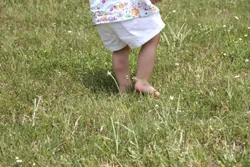Will your kids be playing outdoors in the warm weather? Are you going on vacation to the beach or mountains this summer? If so, it’s important to know how to keep your babies and kids safe from insect stings. Below you will find tips on treating and preventing common stings.

What are the symptoms of a sting from a bee, wasp, hornet or yellow jacket?
Most people who are stung by an insect will have redness, itching, swelling and some pain around the sting site. Although less common, a skin reaction, such as hives, itching and redness, may occur away from the sting site. Severe allergic reactions (anaphylaxis) may occur in some individuals after being stung by bees, wasps or yellow jackets. A severe reaction may occur immediately or hours after a sting. Severe allergic reactions may involve breathing difficulty (wheezing), swelling deep in the throat or low blood pressure.
What do I do if my child is stung by an insect?
1. If a stinger is present, remove it by scraping a card across the wound. Do not touch or squeeze the stinger, which will force more venom (poison) into the skin.
2. Wash the sting site with soapy water.
3. Use a cool compress to reduce pain and swelling.
4. Give your child the appropriate antihistamines for hives and itching.
Individuals who know they are allergic to wasp or bee stings should carry an epinephrine (adrenalin) auto-injector (Epi-Pen) whenever they may be exposed to these insects.
Nine Tips to Keep Kids Safe from Stings
1. Stay away from places where stinging insects are found, such as around flowers, garbage cans, picnic grounds and other places food is kept. ?
2. Be aware of surroundings. Listen for buzzing. Actively look for nests or hives. ?
3. While you and your child are walking in grassy areas, wear long pants, long sleeves, a hat and shoes. Wear gloves if doing an activity such as yard work.
4. Do not go barefoot or wear open-toed shoes on lawns with flowering plants nearby.
5. Wear light-colored clothing. Remember: “Dark blue and black may attract attack.”
6. Carry insect killer with a long spray, but only use it when necessary. Injured insects send out pheromones that attract other insects to their defense. Though repellents are not effective against bees or wasps, the continuous flow of air from an aerosol spray may confuse them, giving you time to escape. ?
7. If attacked, place your hands and forearms across your head to protect your eyes, throat and neck. Brush insects off the skin with a sideways motion. Move away quickly and quietly, as agitated movements and noise can irritate the insects and evoke further attacks. ?
8. If necessary, remove and destroy nests at night when the insects are not active. Use flying insect killer liberally to soak the nest before you remove it. Do not stand below a nest you are removing. Injured insects may fall out of the nest, and while they may not be able to fly, they can still give a painful sting to the first thing they contact, especially an upturned face. ?
9. Don’t wear strong perfumes or cosmetics, particularly floral-scented ones, which can attract bees and wasps. ?
When should I call my pediatrician concerning a sting?
It is best to call for specific instructions if the area where the sting occurred is expanding rapidly or if pain and itching are increasing despite cool compresses and antihistamines. Call your doctor or 911 immediately if your child’s symptoms include difficulty breathing or significant lethargy. Be sure to call anytime an Epi-Pen is required.
DR. MARTIN “MARTY” BELSON, a practicing pediatrician, developed Kid Emergencies.com to provide a free resource to help parents keep their kids safe and healthy. The site is the winner of an iParenting Media Award for the Greatest Products of 2007. For more information, visit www.kidemergencies.com.





















